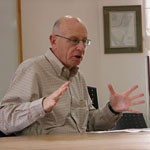By Ira Sharkansky, Ph.D

JERUSALEM — American Jews: Who are they? How many are there? Do they comprise a community? If so, what are the lines of division among them? What about their attitudes and behaviors about Israel?
It’s impossible to answer any of these questions with certainty. There’s a lot of information, but it’s based on surveys, or contentious analyses of documents. And the results differ, both by time and by who has done the research.
Estimates range from 5.4 million to 15 million as the size of the community, based on identification at varying degrees of intensity.
Compare those numbers with the Jews of Israel. That’s also indefinite, or between 6.8 million and 7.2 million, again depending on how one measures it.
Among Americans, somewhere between 14 and 38 percent are Reform, 11-35 percent Conservative, 6-10 percent Orthodox, and 1-3 percent other.
Among those affiliated with a congregation, 20 percent are Orthodox and 7 percent ultra-Orthodox.
Those describing themselves as religious are 3.4 million. Those who identify as culturally Jewish have risen from 20 percent in 1990 to 37 percent in 2008. In the same period, the overall percentage of Americans who say that they have no religion rose from 8 to 15 percent.
The Jewish population is heavily urban, and is concentrated in the areas of New York City, Miami, Los Angeles, Philadelphia, Chicago, San Francisco, Boston, and Baltimore-Washington.
Intermarriage is on the rise. Recently it’s been described as 71 percent of marriages, up from 6 percent in 1950. But we are told that 60 percent of those intermarried are raising their children as Jews.
The population scores as better educated and wealthier than other American groups. Thirty-one percent have a graduate degree, compared with 11 percent of the total American population. And the median family income is $443,000, compared to that of the typical American family at $99,500.
Jews who have been at the pinnacle of the Federal Reserve Board have been Paul Warburg, Eugene Meyer, Arthur F. Burns, Alan Greenspan, Ben Bernanke, and Janet Yellen.
The vast majority are Ashkenazim, and trace their roots to Germans who came in the middle of the 19th century, or to eastern Europeans who came in great numbers after 1880. By 1924 there were restrictive entry requirements, based on national populations prior to 1890. To a certain extent, that move was directed against Jews.
The languages spoken — besides English — have shifted from Yiddish to Hebrew, reflecting both education and the migration of Israelis to the U.S.
Antisemitism has been an issue, more often reported than felt.
Surveys in 2002 and 2005 found 17 or 14 percent of Americans with negative attitudes toward Jews, while surveys in 1992 and 1998 found similar attitudes in 17 and 12 percent of the population. Numbers of negative feelings are higher for Hispanics and Blacks.
Reports of antipathy on college campuses come from Jewish organizations, but a study by Brandeis University found that most Jewish students never experience anti-Jewish remarks or physical attacks.
A study of European Jews reported in Haaretz was headlined that most European Jews are unaffiliated, and are more likely to see themselves as a religious minority rather than an ethnic one. However, there are high proportions identifying themselves as “Just Jewish.”
Politically, the population has been heavily Democratic and liberal, with heights in voting 70-90 percent Democratic for FDR, Lyndon Johnson, Al Smith, Harry Truman, John F. Kennedy, Hubert Humphrey, Jimmy Carter, Bill Clinton, Al Gore,John Kerry, Barack Obama, Hillary Clinton, and Joe Biden.
Between 37 and 45 percent of American Jews say that Israel is important or essential for them, with only 16 percent saying that caring about Israel is not important for them.
Most American Jews, as Democrats, have given negative ratings to both Benjamin Netanyahu and Donald Trump. But 75 percent of Orthodox Jews identify as Republican and give positive ratings to both Netanyahu and Trump.
Israel’s creation, against the history of the Holocaust, began a close relationship between the countries. President Harry Truman was a warm supporter, with a friend and former business partner Eddie Jacobson who introduced Truman to Chaim Weizmann. Truman recognized Israel within minutes of David Ben Gurion’s declaration, despite opposition from the U.S. State Department and elsewhere in the government. The Soviet Union preceded the U.S. with its de jure recognition by something like half a year.
Earlier, in the context of World War I, there was a period of muted American government support for the Balfour Declaration. President Wilson and Colonel House worked in concert or against one another, for and against the Declaration, and ultimately gave their support to it. Louis Brandeis and Chaim Weizmann were important players. The heavy lifting was left to the British, in part because the United States was not at war with the Ottoman Empire, and its control over Palestine.
Left out of this note are what Jewish writers, actors, singers and other artists contribute to the picture of American Jews. It adds profoundly to the sense of mixture and variety, far beyond the dry statistics that fascinate me.
Ira Sharkansky, Ph.D., is professor emeritus of political science at Hebrew University. He may be contacted via ira.sharkansky@sdjewishworld.com